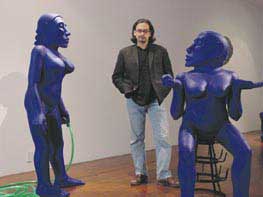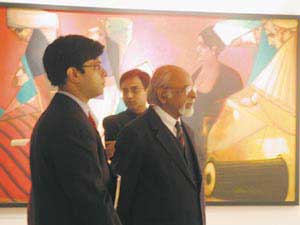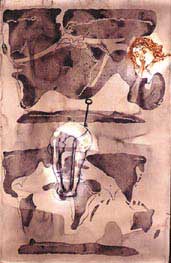Arts
But Can You Eat Art

The economics of Indian art galleries.
|
The economy? Don’t talk about it! Real estate in Manhattan? Pricey as ever. The art market? It’s down. And yet, galleries selling Indian art seem to be surviving quite well, thank you. These galleries are a recent phenomenon. A decade ago, if you had wanted to view a Husain or Raza painting, you could have hunted Manhattan high and low, with nary one in sight. Now there are several galleries in Manhattan showcasing Indian contemporary art and photography: Bose Pacia Modern, Talwar Gallery, Artsindia, Sundaram Tagore Gallery, and Sepia International. So how are these galleries faring in these rough economic times?
Bose Pacia Modern, the pioneer, has been around for almost a decade since Arani Bose and his partner Steve Pacia conceived of the gallery in 1993 and had their first show in 1994. At that time it was the only contemporary art gallery in the United States focusing on India. Bose recalls that when their gallery opened in a small space in Soho, it was literally like swinging in the dark for the public knew and cared little about Indian contemporary art: “Since then the energy of the Indian art scene has allowed for multiple locations of streaming around the world. You started noticing various points of activity – it’s as if something has got into the air and it starts to reverberate, from one to the other – from the gallery perspective, from museums, from auction houses.” As Bose points out, art is kept alive by multiple institutions: commercial galleries, museums, foundations, and auction houses, with a whole cast of characters from gallery owners to curators to dealers: “These really provide the engine, and the fuel of the system is the contemporary artist, and ultimately that whole system is essentially motivated or driven by commerce, by the market. None of them could do what they do, if it weren’t for the market of contemporary art.”
Eight years ago the first dedicated auction of Indian contemporary art took place at Sotheby’s and then at Christies, bringing the post-independence art of India and 20th century art to a worldwide audience. Indian contemporary art hit the awareness of the art world, which was further solidified by the Century City exhibition at the Tate Modern, the temple of modern art, which showcased cities that had a significant impact on the art of their times and Bombay was chosen to represent the 1990s. So is having a gallery focusing only on Indian art viable, especially in a city with over 600 galleries? Says Bose, who declined to share his own financial figures, it is. “You can always make a business viable. The question is how much of what you generate you put back into the business. That reinvestment over time has needed to be more and more.” Bose Pacia has moved to a much larger space in Chelsea and is investing in internationally known artists like Atul Dodiya, Bhupen Khakkar, Arpita Singh, Nalini Malini, and Nilima Sheikh. It is also producing art catalogs that are on par with the mainstream offerings. Says Bose, “The reason is if you’re going to represent the artist on the international scene you have to play in that arena. Over 200 galleries in Chelsea are selling work in a genre that sells for hundreds of thousands of dollars, and we are selling in a genre that sells for tens of thousands of dollars, so that’s the rub.
“It’s the same investment, but our revenue stream is less, because that’s where Indian art is trading right now. But the good news for those interested in collecting, it’s the ability to get involved in a field that is on the launch pad, and that’s what makes it so exciting.” “We’ve been in the black ever since we opened our Fifth Avenue location in 2001,” says Prajit Dutta of Gallery Artsindia. “We do upwards of a million and a half turnover every year. Our traveling shows are successful in winning new clients, but we’ve done well with the New York shows too.” Before opening its doors, the gallery already existed on the web. Now Prajit and his brother Projjal have taken it a step further by taking the art on the road with exhibitions in cities like San Francisco, Dallas, Chicago and Washington, which have large Indian populations.
“We are seeing globally a very distinct upsurge in Indian art,” says Dutta. “Basically it’s the Indians of the Diaspora who are this new audience. There is some amount of non-Indian interest as well, but I don’t think in general there has been a crossover.” The gallery has featured artists like Jehangir Sabarvala, Sanjay Bhattacharya, and Satish Gujral as well as Husain and Jamini Roy. It also recently acquired about 2,000 paintings from the Herwitz Collection, many of them works from the 1960s and 1970s. Deepak Talwar, who opened the Talwar Gallery on 16th Street in 2001, says, “It is a vast market out there, because the contemporary art collecting market in this country is huge. It doesn’t matter where the artist is from, what filters through the artist’s work is important. So I don’t put the limitation of that very narrow definition of Indian contemporary art on my artists.” Talwar Gallery shows avant-garde artists of Indian origin such as Los Angeles- based conceptual photo artist Allan deSouza, film artist Alia Syed from London and the installation art of A. Balasubramanium, based in Bangalore.
He adds that a large portion of his clientele is not Indian, and the discourse should be about art, not about geographical or political boundaries on art. “My artists may be of Indian origin, that may be the common thread, but when you step into the gallery, it’s the art that counts. People still expect Indian art to be like two-dimensional paintings that are hanging on the wall, with some Indian motif. You have to get beyond the image, and the Indian audience is still making efforts to develop that.” While he says that the gallery has been successful beyond his expectations, Talwar too declines to give figures. “The gallery is doing fine. If not, the doors would have closed. I think survival should not be measured in numbers. If the doors are open, and it’s showing quality art, it lives – it’s breathing. So long as it’s breathing, it’s alive.” Talwar says that in their obsession with prices and numbers, people are missing the big picture: they are missing the art. He believes the success of a gallery goes beyond the financial picture to the educating of first time buyers and the pleasure art gives. “It’s not a simultaneous exchange where a gallery gets art and starts to sell it immediately to cover its cost. It’s not about that. It’s about investing in something you believe in and it’s about making people realize the power of art. So a gallery is not a ‘dukan’ or a shop to just buy and sell. It’s got a bigger purpose than that.” |






You must be logged in to post a comment Login